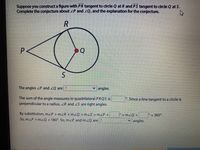
Elementary Geometry For College Students, 7e
7th Edition
ISBN: 9781337614085
Author: Alexander, Daniel C.; Koeberlein, Geralyn M.
Publisher: Cengage,
expand_more
expand_more
format_list_bulleted
Concept explainers
Question

Transcribed Image Text:Suppose you construct a figure with PR tangent to drcle Q at R and PS tangent to clrcle Q at S.
Complete the conjecture about ZP and 2Q, and the explanation for the conjecture.
P.
Q
The angles ZP and ZQ are ?
v angles.
The sum of the angle measures in quadrilateral PRQS is
perpendicular to a radius, ZR and S are right angles.
°. Since a line tangent to a circle is
By substitution, m/P + mZR +mZQ +m S=mZP+
So, mZP +mZQ = 180°. So, mZP and mzQ are ?
+ mzQ +
= 360°.
angles.
Expert Solution
This question has been solved!
Explore an expertly crafted, step-by-step solution for a thorough understanding of key concepts.
This is a popular solution
Trending nowThis is a popular solution!
Step by stepSolved in 2 steps

Knowledge Booster
Learn more about
Need a deep-dive on the concept behind this application? Look no further. Learn more about this topic, geometry and related others by exploring similar questions and additional content below.Similar questions
- 5. If 2JEL and are adjacent angles, then ZJEL +ZLEO- 180°. PERFORMANCE TASKS: Direction: In the given figure, GRAYis a rectangle. Complete the conclusion and write the reasons that will justify each of the statements. Y. 1. If Sis the midpoint of GA, then 2. If GA bisects RY, then 3. If GR is perpendicular to RA , 4. If ZGRA and ZRAY are supplementary angles, then then 5. If ZGYS and ZSYA formed a right angle, then SCHOOLS DIV Bridging learners to a brighter future. I CAGAYAN DEarrow_forward2. Find the missing angles labelled in each of these circles. a. 31° b. Ý SOE BỘ 80+2 90-y 2x+4 C. 12cm Scmyarrow_forward
Recommended textbooks for you
 Elementary Geometry For College Students, 7eGeometryISBN:9781337614085Author:Alexander, Daniel C.; Koeberlein, Geralyn M.Publisher:Cengage,
Elementary Geometry For College Students, 7eGeometryISBN:9781337614085Author:Alexander, Daniel C.; Koeberlein, Geralyn M.Publisher:Cengage, Elementary Geometry for College StudentsGeometryISBN:9781285195698Author:Daniel C. Alexander, Geralyn M. KoeberleinPublisher:Cengage Learning
Elementary Geometry for College StudentsGeometryISBN:9781285195698Author:Daniel C. Alexander, Geralyn M. KoeberleinPublisher:Cengage Learning

Elementary Geometry For College Students, 7e
Geometry
ISBN:9781337614085
Author:Alexander, Daniel C.; Koeberlein, Geralyn M.
Publisher:Cengage,

Elementary Geometry for College Students
Geometry
ISBN:9781285195698
Author:Daniel C. Alexander, Geralyn M. Koeberlein
Publisher:Cengage Learning